Spicy and lip-smacking Dhaniya Kuzhambu / Coriander flavored tamarind gravy/stew with fresh ingredients, that pairs well with plain steamed rice.
This Dhaniya kuzhambu is a perfect rice accompaniment loaded with the flavors of shallots, Moringa pods and of course coriander seeds. Learn how to make this kuzhambu with step-wise pictures!
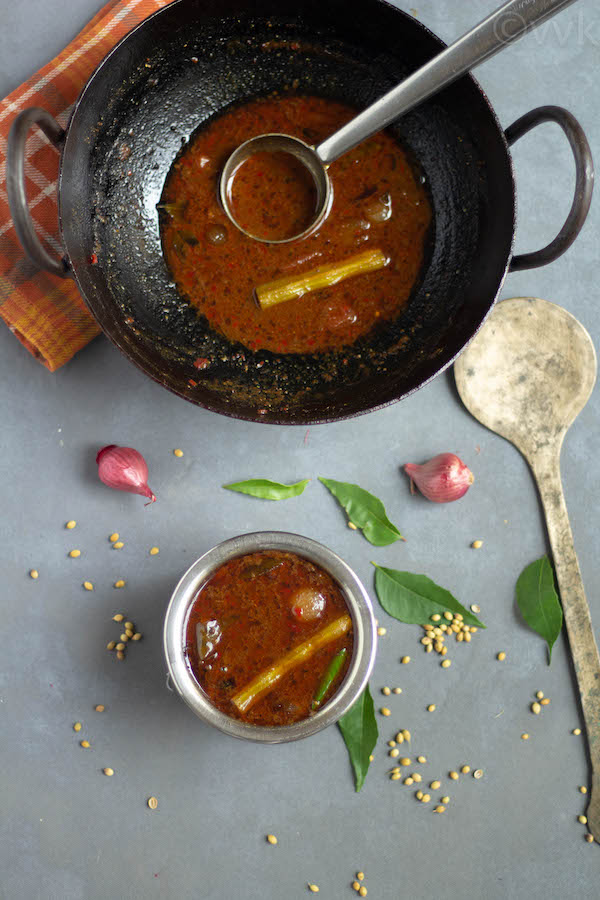 I always lookout for new dal, sambar, and kuzhambu recipes, I think we all do. :-) A few months back, while chatting with our friend Iswarya, I got to know about this gravy. I immediately asked for the recipe, and she duly shared. I have tried it quite a few times after that with different vegetables, with and without garlic and guess what, every single time it comes out delicious.
I always lookout for new dal, sambar, and kuzhambu recipes, I think we all do. :-) A few months back, while chatting with our friend Iswarya, I got to know about this gravy. I immediately asked for the recipe, and she duly shared. I have tried it quite a few times after that with different vegetables, with and without garlic and guess what, every single time it comes out delicious.
If you are wondering what kuzhambu (pronounced as Ku-lam-bu) is, then here is the short answer. Kuzhambu is a Tamil word which means tamarind based gravy/stew. Some kuzhambu varieties are thick like a stew and some are like gravy. Like sambar, there are different varieties, and I have quite a few on my blog as well like vathal kuzhambu / gravy with sun-dried fryums, katharikai puli kuzhambu / tangy gravy with eggplant, maanga kuzhambu / raw mango gravy, etc.
The flavor of this kuzhambu comes from the fresh spices – coriander seeds and red chilies. We need to dry roast and grind them for this kuzhambu. You also need sambar powder for this recipe. I used my homemade sambar powder, but you can use store-bought one as well.
Now you can ask me instead of dry roasting coriander seeds and red chilies and grinding them, can I use coriander powder and red chili powder? A big no is my answer. The freshly roasted and ground coriander seeds and red chilies add all the magic to this kuzhambu. Nothing can beat fresh spices. So don’t use the ready-made ones. Trust me; it takes less than 10 minutes to roast and grind the spice powder. You won’t regret this extra effort after tasting the kuzhambu.
What Veggies should you use in this Kuzhambu?
For this recipe, I used drumsticks or the moringa pods. But you can swap it with okra or Indian eggplants. These three really go well in this kuzhambu.
Also, I would recommend using shallots, but if it is hard to source or if you find it difficult to peel, you can use one medium-sized red onion. You can also add up to 5 garlic cloves for this kuzhambu. But don’t go overboard with garlic. For today’s recipe, I did not use any garlic.
I prefer sesame oil/gingelly oil but you can use any neutral oil for this. Optionally add a dollop of ghee while serving but not for tempering. This coriander flavored tamarind gravy/stew is all vegan folks!
Tamarind Juice
The tanginess and color of the kuzhambu depends upon the tamarind. As always I went with the paste for this recipe, but you can also use the pods or block. In that case, use a small lemon sized ball of tamarind. Soak the tamarind in 2 cups of hot water for 30 to 45 minutes. Once it softens, squeeze the tamarind flesh as much as you can. Discard the pulp and strain the liquid. As this recipe needs two cups of water, you can directly soak in two cups of water and extract the juice.
How to make Dhaniya kuzhambu / Coriander Flavored Tamarind Gravy?
Now let me share how to make this dhaniya kuzhambu in detail. Don’t forget to check the recipe notes section for some alternatives and suggestion.
Step 1 – Prepare the Spice Powder
- Heat a kadai or wok and add the coriander seeds and dried red chilies.
- Dry roast it for 90 seconds to 120 seconds over medium heat or until the coriander seeds turn light brown. Turn off the heat and allow it to cool.
- Grind it coarsely and set it aside.
Step 2 – Prepare the Tempering
- Heat a wok or kadai and add 3 tbsp of sesame/gingelly oil. When the oil is hot, add the mustard seeds, fenugreek seeds, curry leaves, and asafetida. Let it fry for 30 seconds.
Step 3 – Adding the Vegetables
- Then add the shallots and cook for one minute.
- Next add the chopped tomato, drumstick pieces, salt, and the sambar powder. Mix thoroughly and cook for one minute.
Step 4 – Cook the Vegetables
- Meanwhile, mix 1 tbsp of tamarind paste in 2 cups of water and add it to the kuzhambu.
- Over medium heat, let it simmer for 15 minutes so that the drumstick softens. If you are using brinjal or okra, simmer it for 10 minutes.
Step 5 – Add the Spice Powder and Simmer
- Now add the freshly ground powder and simmer over medium-low heat for ten more minutes.
- After 10 minutes, turn off the heat. Delicious dhaniya kuzhambu is ready.
- Serve hot with plain white rice and applam/papad or any dry curry like Instant Pot green beans poriyal.
PS: After transferring the kuzhambu from the kadai, add about ¼ cup of cooked rice in the kadai and mix it and relish that rice. It tastes delicious.
Recipe Notes:
- Adjust the salt and spices (number of red chilies and sambar powder) according to your preference.
- If you are using tamarind block or pod, use a small lemon sized ball for this recipe. Soak in hot water and extract the juice as mentioned in the post.
- Instead of moringa pods, you can use okra or brinjal.
- Shallots are preferable, but you can use red onions instead.
- You can use garlic cloves as well. Five cloves would suffice for this measure.
- Like shallots, I would recommend sesame/gingelly oil for this kuzhambu, but if you can’t source it, you can use neutral oil or peanut oil.
- You can simmer it for a longer time and make it like a thick stew. If you want thin consistency more like gravy, add ½ cup of water and simmer it.
PS: Follow me on Instagram or join my Facebook Group for more gardening and recipe updates. If you try this dhaniya kuzhambu, please don’t forget to comment and rate this recipe.
Other Kuzhambu Varieties-
- Poondu kuzhambu
- Cauliflower kurma kuzhambu
- Coconut milk kuzhambu
- Vathal kuzhambu
- Arachuvitta vatha kuzhambu
📖 Recipe
Dhaniya Kuzhambu
Equipment
- wok or kadai
Ingredients
To roast and grind
- 2 tbsp coriander seeds
- 2 dried red chilies
For the kuzhambu
- 3 tbsp sesame oil
- 1 tsp mustard seeds
- ½ tsp fenugreek seeds
- 10 curry leaves
- ½ tsp asafetida
- 10 shallots peeled
- 1 tomato medium-sized, finely chopped
- 6 moringa pods drumstick pieces, 2 to 2.5-inch piece
- 1 tbsp kosher salt
- 1 tbsp sambar powder
- 2 cups of water
- 1 tbsp tamarind paste
Instructions
Prepare the Coriander Powder:
- Heat a kadai or wok and add the coriander seeds and dried red chilies.
- Dry roast it for 90 seconds to 120 seconds over medium heat or until the coriander seeds turn light brown.
- Turn off the heat and allow it to cool.
- Grind it coarsely and set it aside.
Make the Kuzhambu:
- Heat a wok or kadai and add 3 tbsp of sesame/gingelly oil. When the oil is hot, add the mustard seeds, fenugreek seeds, curry leaves, and asafetida. Let it fry for 30 seconds.
- Then add the shallots and cook for one minute.
- Next add the chopped tomato, drumstick pieces, salt, and the sambar powder. Mix thoroughly and cook for one minute.
- Meanwhile, mix 1 tbsp of tamarind paste in 2 cups of water and add it to the kuzhambu.
- Over medium heat, let it simmer for 15 minutes so that the drumstick softens. If you are using brinjal or okra, simmer it for 10 minutes.
- Now add the freshly ground powder and simmer over medium-low heat for ten more minutes.
- After 10 minutes, turn off the heat. Delicious dhaniya kuzhambu is ready.
- Serve hot with plain white rice and applam/papad or any dry curry.
Notes
- Adjust the salt and spices (number of red chilies and sambar powder) according to your preference.
- If you are using tamarind block or pod, use a small lemon sized ball for this recipe. Soak in hot water and extract the juice as mentioned in the post.
- Instead of moringa pods, you can use okra or brinjal.
- Shallots are preferred, but you can use red onions instead.
- You can use garlic cloves as well. Five cloves would suffice for this measure.
- Like shallots, I would recommend sesame/gingelly oil for this kuzhambu, but if you can't source it, you can use neutral oil or peanut oil.
- You can simmer it for a longer time and make it like a thick stew. If you want thin consistency more like gravy, add ½ cup of water and simmer it.
Nutrition
I am not a nutritionist. The nutritional information is provided as a courtesy and is an estimate only. It varies depending upon the product types or brands.


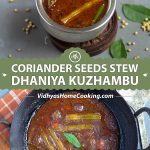
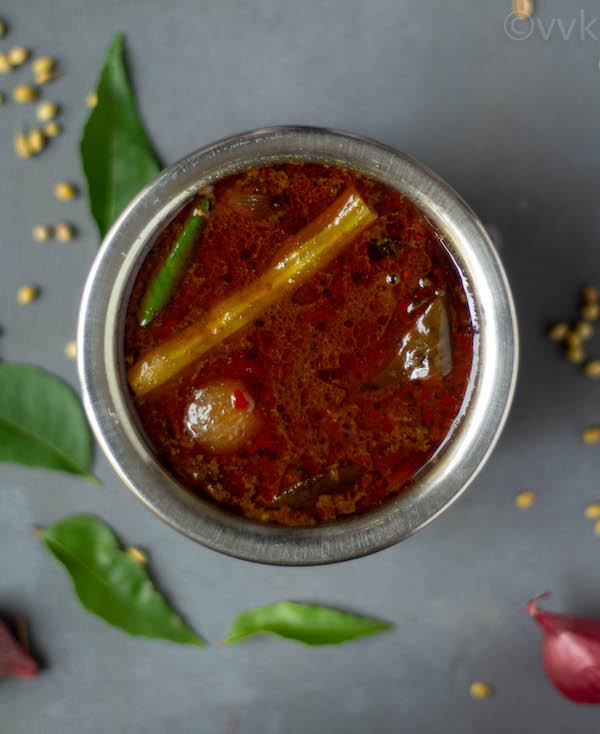
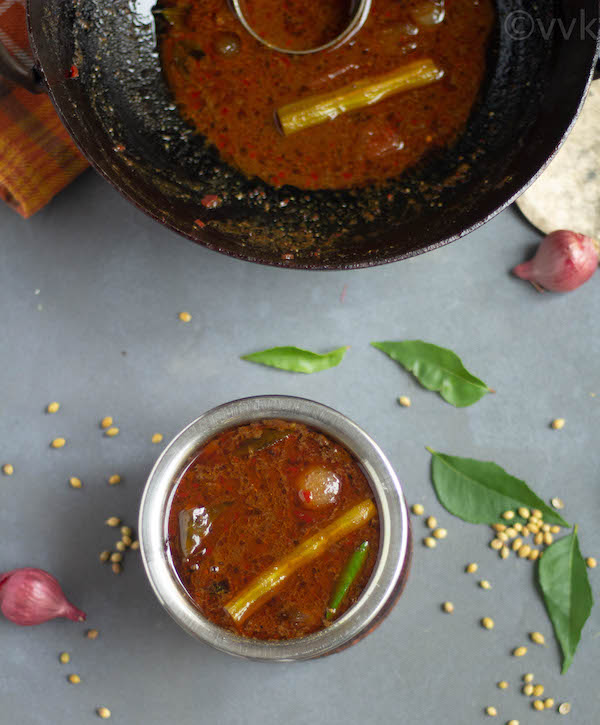
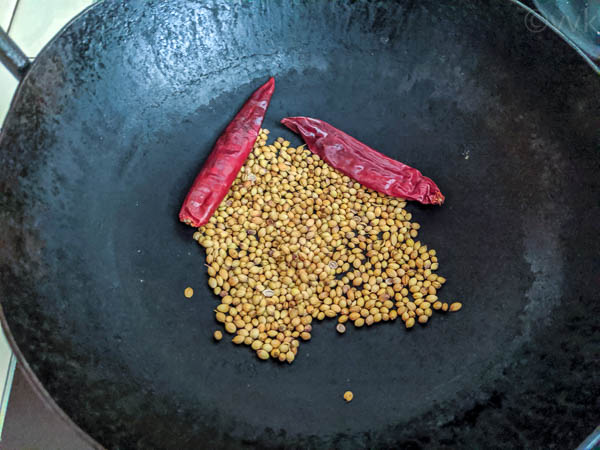
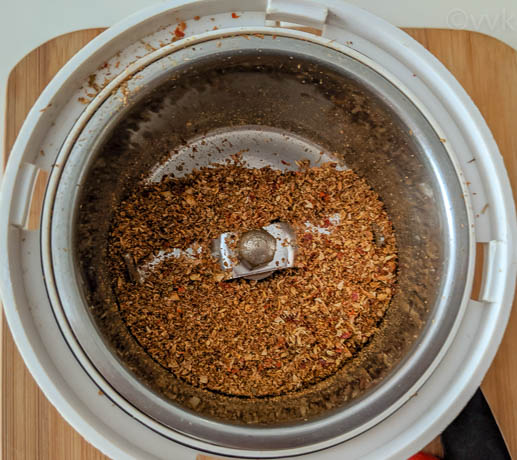
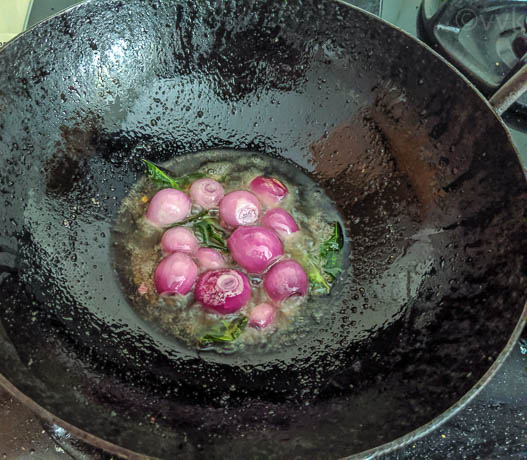
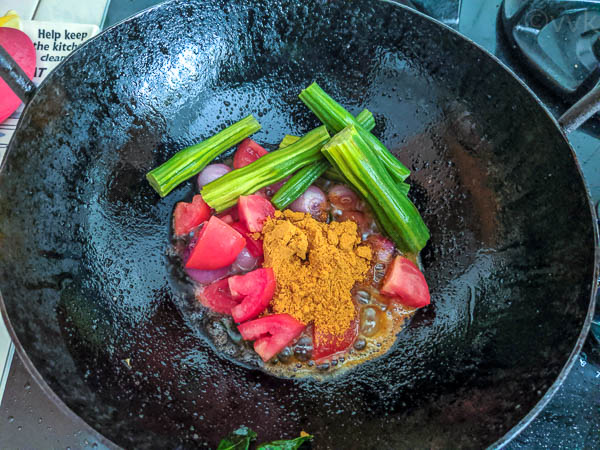
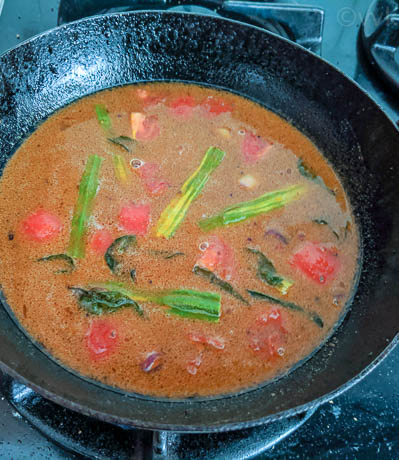
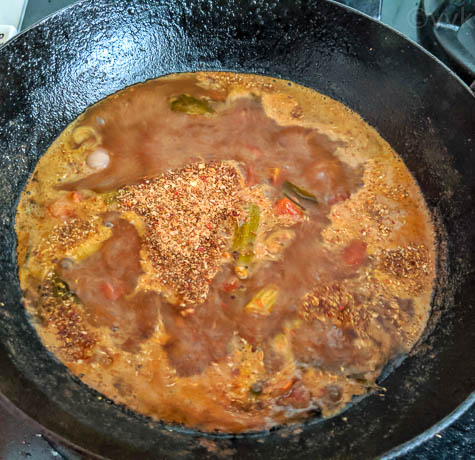
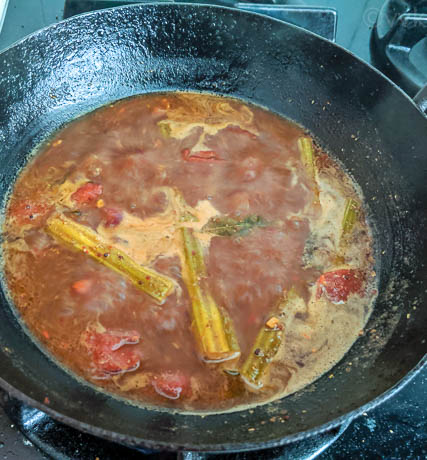
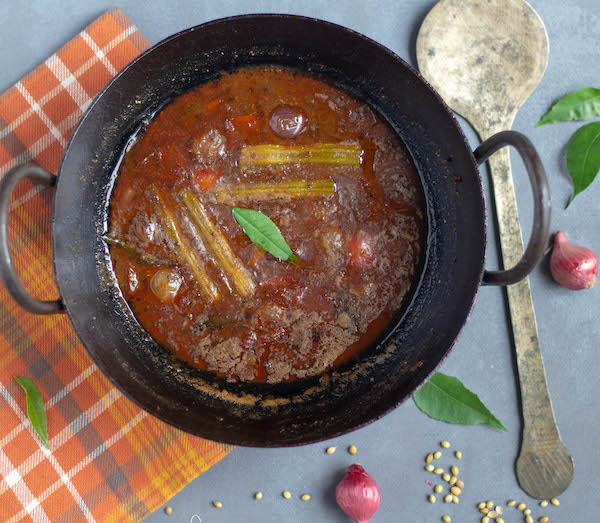
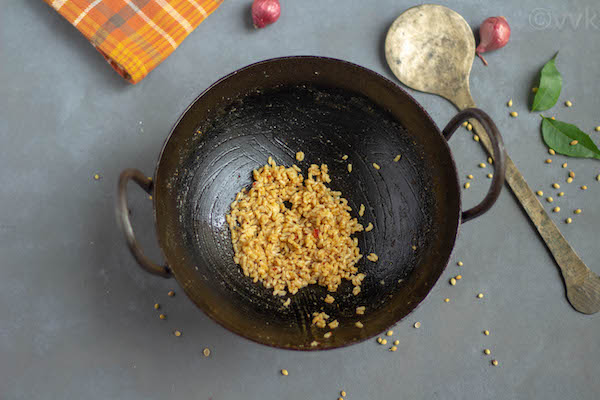
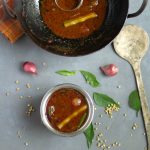

Leave a Reply